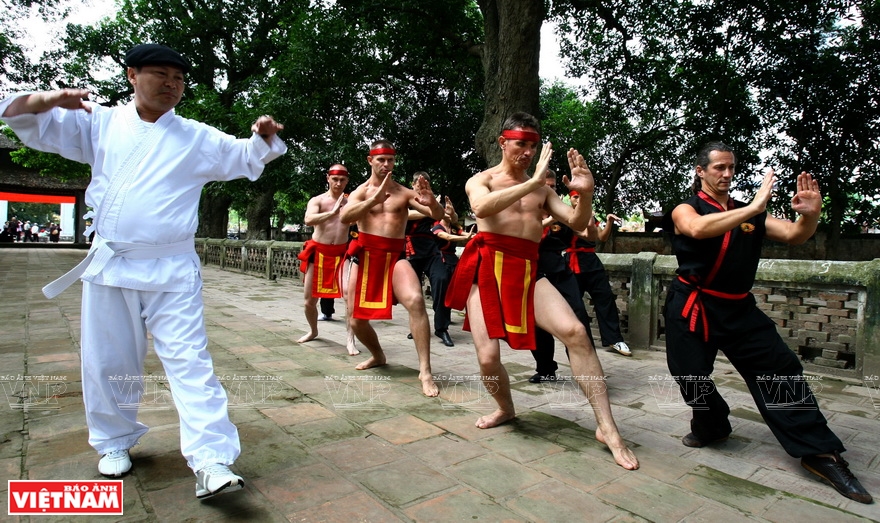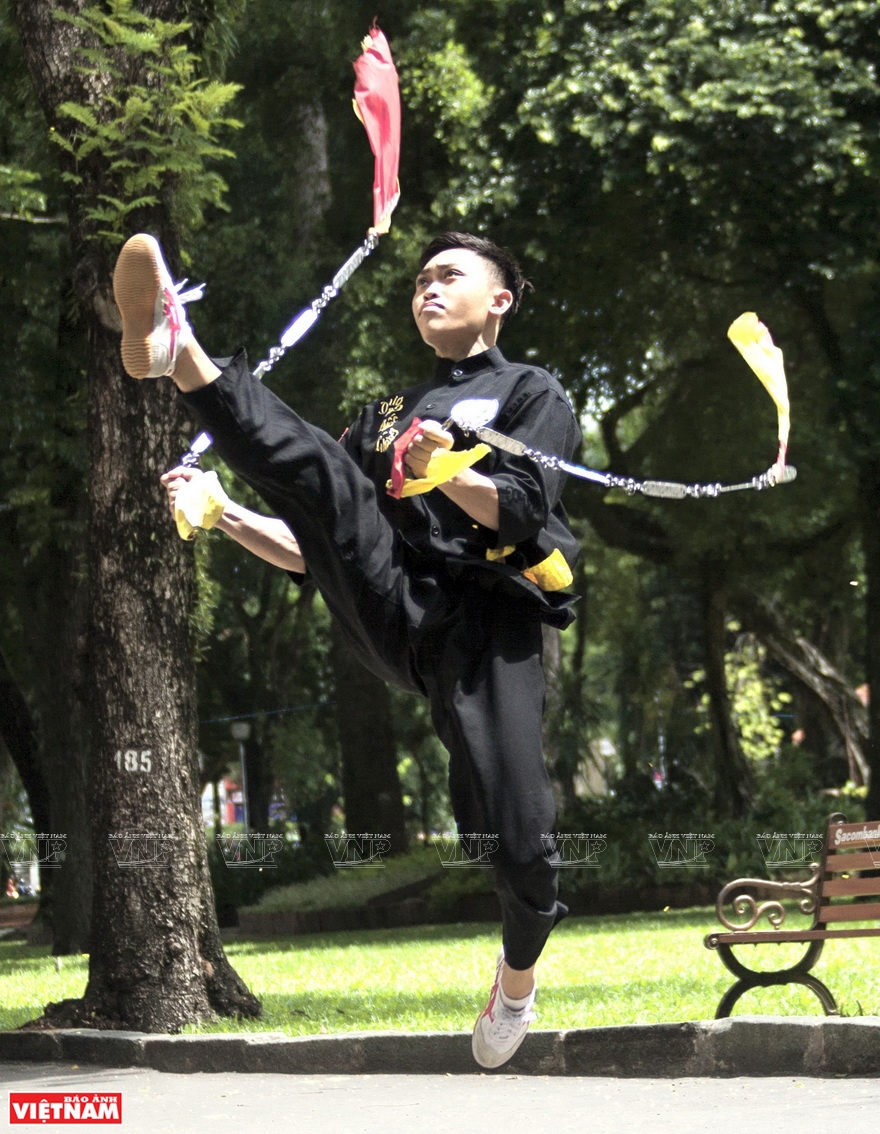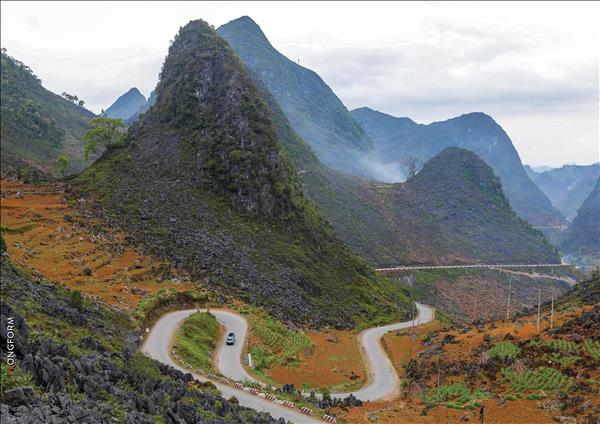Long history of development
Vietnam’s traditional martial arts, a cultural heritage of the Vietnamese people, are styles of martial arts created by Vietnamese or introduced into Vietnam but adapted by Vietnamese to fit their physical fitness, culture and martial arts philosophy. The martial arts have been handed down from one generation to another.
The Vietnamese have, for thousands of years, developed traditional martial arts in comprehensive aspects. These include the principles, formalities and conducts, ethics, fighting techniques, music and tunics of the martial arts. There are martial arts for royal guards, rules of royal martial arts competitions, and martial arts medicine (traditional medicine combined with martial arts techniques for medical treatment.)
Technically, Vietnam’s traditional martial arts neither regard the beauty of stances as the key factor nor attach too much importance to force like other martial arts in the world.
Vietnam’s traditional martial arts deploy practical and flexible stances suitable for the figures and physical strength of Vietnamese people. The basic philosophy of Vietnam’s traditional martial arts is using weakness to compel strength; small in number to beat large in number; and shortness to win length. They also consider the attack as self-defense with flexible use of firmness and softness. The martial arts’ stances are simple but dangerous and effective, with flexible and swift attacks and practical and tight defense.
Vietnam’s traditional martial arts, a cultural heritage of the Vietnamese people, are styles of martial arts created by Vietnamese or introduced into Vietnam but adapted by Vietnamese to fit their physical fitness, culture and martial arts philosophy. The martial arts have been handed down from one generation to another.
The Vietnamese have, for thousands of years, developed traditional martial arts in comprehensive aspects. These include the principles, formalities and conducts, ethics, fighting techniques, music and tunics of the martial arts. There are martial arts for royal guards, rules of royal martial arts competitions, and martial arts medicine (traditional medicine combined with martial arts techniques for medical treatment.)
Technically, Vietnam’s traditional martial arts neither regard the beauty of stances as the key factor nor attach too much importance to force like other martial arts in the world.
Vietnam’s traditional martial arts deploy practical and flexible stances suitable for the figures and physical strength of Vietnamese people. The basic philosophy of Vietnam’s traditional martial arts is using weakness to compel strength; small in number to beat large in number; and shortness to win length. They also consider the attack as self-defense with flexible use of firmness and softness. The martial arts’ stances are simple but dangerous and effective, with flexible and swift attacks and practical and tight defense.
 Nhat Nam martial art draws many foreign learners. Photo: VNP Files Elbow and knee techniques are typical of Vietnam’s martial arts. Photo: Thanh Giang Using a staff, which was compulsory in martial arts competitions in the past, is still practiced at Ky Son martial arts school in Hoi An, Quang Nam. Photo: VNP Files  Jar is a special and creative weapon, used by martial artists in Thu Dau Mot, Binh Duong. Thu Dau Mot is home to a well-known jar craft village. Photo: Nguyen Luan  Song thiet, which is a pair of five-link chains, each with a handle on one end and a sharp steel spearhead on the other end, is a dangerous weapon created by late master Le Van Kien, head of Nam Tong martial art in Ho Chi Minh City. Photo: VNP Files  Apart from their practical and dangerous stances, Vietnam’s martial arts own qigong exercises which help build special endurance and strength for practitioners. Photo: Thanh Giang
There are more than 100 styles of Vietnamese martial arts each of which has its own unique techniques. Photo: VNP Files
 A Vovinam counter performance at the 8th Vietnam National Games 2019. Photo: VNA |
The use of weapons in Vietnam’s martial arts is also creative and flexible. Apart from bows and arrows, lances, spears, staffs, knives, and swords, the Vietnamese turn daily-life utilities such as hoes, shovels, oars, shoulder poles, jars, pots, scarves and loin-cloths into dangerous weapons in case of urgent defense. This is rarely seen in other martial arts.
Traditional martial arts were developed during the feudal reigns. In the Tran dynasty in the 13th century, a martial arts school was opened for royal family members. In the Le dynasty in the 18th century and the Nguyen in the 19th century, martial arts competitions were held to find talent for the country. A martial arts temple was also built to honor talented martial artists.
“The Vietnamese Traditional Martial Arts Federation (VTMAF) is implementing long-term programs to restore, preserve, develop and promote Vietnam’s martial arts to the world”, said Dr. Hoang Vinh Gang, VTMAF President and President of the World Federation of Vietnamese Traditional Martial Arts. The programs include a plan to preserve and develop Vietnam’s traditional martial arts to 2020. An Institute of Vietnamese Traditional Martial Arts and a Council of Vietnamese Traditional Martial Artists composed of famous martial artists will be established to survey and study ancient martial arts exercises and specific techniques of major martial arts styles in Vietnam. A system of competitions and performances of Vietnamese traditional martial arts, including regional and world competitions will also be developed.
With their original values, Vietnam’s traditional martial arts can be said to be at the same level as any other in the world, such as Japan’s Karate, Kendo and Sumo; Korea’s Taekwondo, China’s Shaolin, Emei and Wudang, Pencak Silat of Indonesia and Malaysia.
|
The country now has 700 martial arts schools and clubs which have more than 100 styles with around 60,000 practitioners. There are 600 martial arts masters at grade 18 (the highest level), 500 senior coaches at grade 17 and 550 coaches at grades 16 and 15.
The General Department of Sports and Physical Training’s Plan
on preservation and development of Vietnam’s traditional martial arts to 2020 |
Growing popular around the world
An estimated 400 Vietnamese martial arts training centers are operating in nearly 50 countries and territories with hundreds of thousands of regular practitioners, including nearly 1,000 martial arts masters and senior coaches. This shows the popularity of Vietnamese martial arts in the world.
Before 1975, Vietnam’s traditional martial arts were introduced in several countries by immigrant Vietnamese martial artists who opened schools to train Vietnamese and foreigners.
After the country was reunified in 1975, the training and practice of Vietnamese martial arts overseas grew quickly, particularly after the establishment of the Vietnamese Martial Arts Federation in 1991 and the World Federation of Vietnamese Martial Arts in 2015. Many Vietnamese martial arts masters have been sent to other countries to train in the traditional martial arts. Foreign martial artists have also come to Vietnam to learn the quintessence of the Vietnamese martial arts.
Prominent in introducing Vietnam’s martial arts to the world are masters Le Kim Hoa, head of Thanh Long martial art, Ngo Xuan Binh, head of Nhat Nam, Lam Thanh Khanh, head of Hong Gia Quyen and Le Dinh Long, head of Kim Ke Tay Son Nhan.
Vietnam has organized international Vietnamese martial arts festivals and competitions, including the world championship of Vietnamese martial arts in 2016 and 2018, and the world cup of Vietnamese martial arts in Marseille, France in May 2019. These events attracted thousands of martial artists, competitors and martial arts researchers from countries on the five continents.
Vietnam’s Vovinam was an official sport at the SEA Games 2011 and 2013, and Asian Beach Games 2015. It is also expected to be at SEA Games 2019 in the Philippines. The country is seeking ways to introduce Vovinam and some other traditional martial arts as an official sport not only at SEA Games but at regional and international sporting events.
Thomas Bach, President of the International Olympic Committee and an Olympic fencer, visited Bach Ho Lam martial art school of master Ho Van Giao in Da Nang during his attendance at the Asian Beach Games in Da Nang in 2016. Bach was impressed by the Vietnamese people’s passion for martial arts and their hard practice regardless of their age and occupations. He said that this was a model for other countries with traditional martial arts to study for preservation and development of their own traditional martial arts.
Story: Thanh Hoa & Son Nghia
Before 1975, Vietnam’s traditional martial arts were introduced in several countries by immigrant Vietnamese martial artists who opened schools to train Vietnamese and foreigners.
 Nguyen Mai Trinh (left) is the wife of master Stephane Lesoil. She is a member of the Ho Chi Minh City Traditional Martial Arts Federation and has achieved high marks. Photo: Son Nghia  French master Stephane Lesoil teaches an arm lock exercise. Photo: Son Nghia Nhat Nam martial arts is practiced in many countries of the former Soviet Union. Photo: VNP Files  Followers of Tieu Long, a martial art style developed by French master Stephane Lesoil, use both Vietnamese martial arts exercises and those of its own. Photo: Son Nghia The World Federation of Vietnamese Traditional Martial Arts was established in 2015, and has become a common home for international lovers of Vietnamese martial arts. Photo: Thanh Giang |
After the country was reunified in 1975, the training and practice of Vietnamese martial arts overseas grew quickly, particularly after the establishment of the Vietnamese Martial Arts Federation in 1991 and the World Federation of Vietnamese Martial Arts in 2015. Many Vietnamese martial arts masters have been sent to other countries to train in the traditional martial arts. Foreign martial artists have also come to Vietnam to learn the quintessence of the Vietnamese martial arts.
Prominent in introducing Vietnam’s martial arts to the world are masters Le Kim Hoa, head of Thanh Long martial art, Ngo Xuan Binh, head of Nhat Nam, Lam Thanh Khanh, head of Hong Gia Quyen and Le Dinh Long, head of Kim Ke Tay Son Nhan.
Vietnam has organized international Vietnamese martial arts festivals and competitions, including the world championship of Vietnamese martial arts in 2016 and 2018, and the world cup of Vietnamese martial arts in Marseille, France in May 2019. These events attracted thousands of martial artists, competitors and martial arts researchers from countries on the five continents.
Vietnam’s Vovinam was an official sport at the SEA Games 2011 and 2013, and Asian Beach Games 2015. It is also expected to be at SEA Games 2019 in the Philippines. The country is seeking ways to introduce Vovinam and some other traditional martial arts as an official sport not only at SEA Games but at regional and international sporting events.
Thomas Bach, President of the International Olympic Committee and an Olympic fencer, visited Bach Ho Lam martial art school of master Ho Van Giao in Da Nang during his attendance at the Asian Beach Games in Da Nang in 2016. Bach was impressed by the Vietnamese people’s passion for martial arts and their hard practice regardless of their age and occupations. He said that this was a model for other countries with traditional martial arts to study for preservation and development of their own traditional martial arts.
| Apart from the World Federation of Vietnamese Traditional Martial Arts, there are regional and national Vietnamese martial arts organizations, including the Asian Federation of Vietnamese Martial Arts, South Asian Federation of Vietnamese Martial Arts, Southeast Asian Federation of Vietnamese Martial Arts, African Federation of Vietnamese Martial Arts, and Vietnamese Martial Arts Federations in France, Italy and Russia. Vietnam’s traditional martial arts are set to expand to 60 countries and territories by 2020, and to 100, by 2030. |
Story: Thanh Hoa & Son Nghia
Photos: Thanh Giang, Son Nghia, Nguyen Luan, VNP Files & VNA







